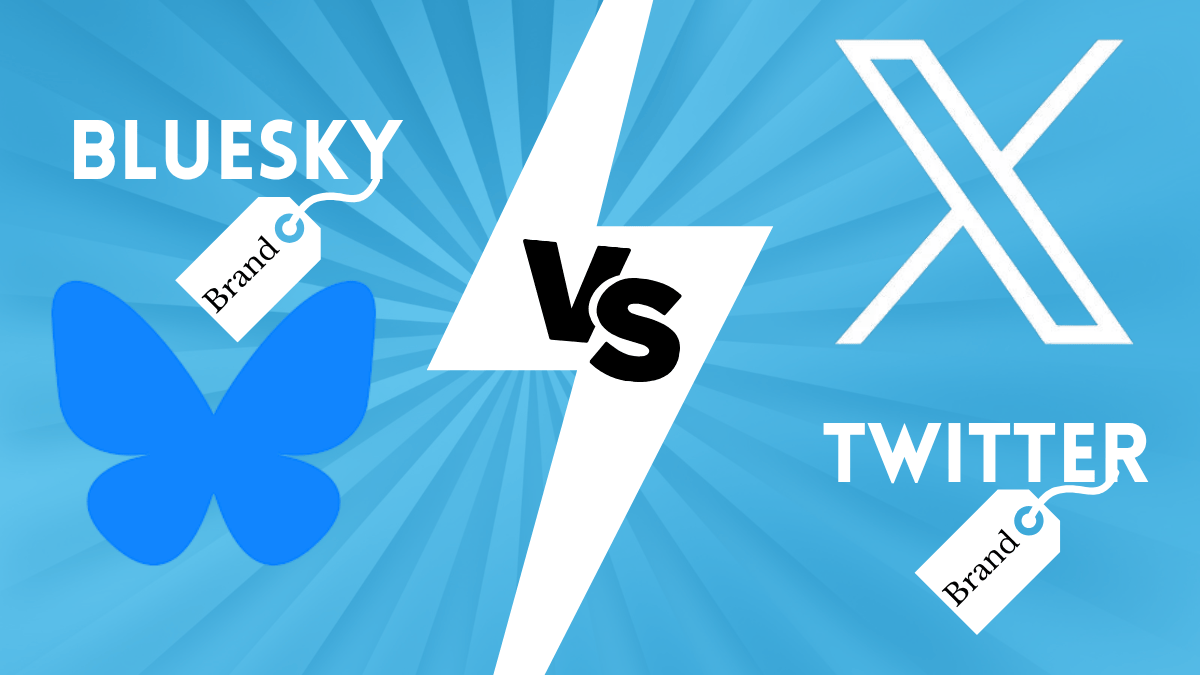Bluesky vs Twitter: Which Is the Better Social Media Platform?
Are you trying to figure out whether Bluesky vs Twitter is the better social media platform for you? In this article, we’ll break down the main differences between Bluesky and Twitter, covering everything from their origins to their user experiences. Get ready to discover which platform might be a better fit for your social media needs.
Key Takeaways
Bluesky is a decentralized social media platform built on the AT Protocol, emphasizing user control over data and content moderation, contrasting with Twitter/X’s centralized governance.
User experience on Bluesky prioritizes a minimalist interface and customizable feeds, promoting organic interactions, while Twitter/X is characterized by a more cluttered, algorithm-driven environment.
Bluesky’s rapid user growth and focus on positive community dynamics appeal to younger demographics, while Twitter/X remains popular due to its extensive reach and established user base.
Bluesky's Origin and Purpose
Bluesky emerged from a research initiative within Twitter aimed at creating a decentralized social network. Initially, an internal project started in 2019, it became an independent entity in 2021 with a clear mission: to create a decentralized communication protocol that grants users more control over their social media experience. This shift aimed to address growing concerns about data privacy and platform control, focusing on user autonomy and freedom of speech.
Bluesky operates on the AT Protocol, designed to support its decentralized platform and ensure that users have more say in how their data is used and how content is moderated. This open and decentralized nature is what makes Bluesky stand out, offering a new way for users to engage in social media without the constraints of a centralized authority. The platform launched as an invite-only beta version in February 2023, aiming to create a safer online environment by mitigating misinformation.
The essence of Bluesky lies in its commitment to decentralization and user control, providing an alternative to traditional social media platforms. Bluesky aims to redefine the social media landscape by enabling users to influence feed algorithms and fostering transparency and trust. This makes Bluesky not just a new platform, but a potential game-changer in how we interact online.
Twitter/X Evolution Post-Elon Musk
Elon Musk’s takeover of Twitter in 2022 marked a significant shift in the platform’s trajectory. Notable changes included:
Introduction of a paid verification model, where users could purchase a blue tick and verification badges.
Concerns about impersonation and authenticity, as the blue checkmark no longer represented verified credibility, raising issues around account verification.
Prioritization of posts from paying users, making it more challenging for smaller accounts to achieve organic reach.
Under Musk’s leadership, Twitter/X also saw the reintroduction of political ads with greater transparency requirements and the allowance of longer posts up to 25,000 characters. While these changes aimed to enhance user engagement and advertising revenue, they also sparked debates about the platform’s direction and commitment to free speech. Many users expressed concerns over policy shifts and content moderation issues, prompting a search for alternative platforms with fewer ads.
Despite these changes, Twitter/X retains its massive user base, providing significant reach for brands and individuals looking to maintain visibility. The platform’s evolution under Musk reflects a broader trend in social media that has gained popularity towards monetization and policy flexibility, yet it also underscores the growing demand for platforms that prioritize user control and decentralized governance.
Key Differences Between Bluesky and Twitter/X
The primary distinction between Bluesky and Twitter/X lies in their structural models. Bluesky is built on a decentralized framework using the AT Protocol, offering users more control over their data and feed algorithms. In contrast, Twitter/X operates under a centralized model where content moderation and algorithmic controls are dictated by the platform itself. This fundamental difference influences user autonomy and the overall social media experience on each platform.
Bluesky aims to recreate the eclectic feel of old Twitter while providing a more community-driven and decentralized app experience. Twitter/X account, with its centralized content moderation policies, offers a less flexible user experience.
Brands and users alike must weigh the benefits of Bluesky’s emerging strategies and user control, worth noting the experiences of other users, against Twitter/X’s vast reach and centralized governance, especially in light of the widespread adoption of new technologies.
Content Moderation Policies
Content moderation is a critical aspect where Bluesky and Twitter/X diverge significantly. Bluesky’s approach includes:
Community involvement in moderation, enabling users to report content and create lists of accounts to block or mute
A modular moderation system with dedicated teams
Automated systems
Third-party moderation services This provides a more tailored and user-driven environment.
In stark contrast, Twitter/X follows a centralized moderation approach, applying uniform policies across its platform. Elon Musk’s acquisition led to a push for greater free speech, altering content moderation policies to allow more previously restricted content. This has been met with mixed reactions, as some users appreciate the freer environment while others are concerned about the potential for misinformation and harmful content.
Bluesky’s community-driven moderation offers several advantages:
Users can set their own content policies, aligning with their values and enhancing trust.
Brands can create moderation lists that align with their messaging, leveraging flexibility.
This approach provides a unique advantage over Twitter/X’s more rigid system.
The decentralized moderation model could be a deciding factor for users and brands considering a switch to Bluesky, following the community guidelines.
User Experience and Interface Comparison
User experience on Bluesky is designed to be minimalist and user-centric, promoting ease of navigation and a clutter-free interface. The platform allows users to create custom feeds with different algorithms, including their own algorithms, for specific content categories, providing more control over what they see. This decentralized model contrasts sharply with Twitter/X, where the feed is algorithm-driven and prioritizes trending topics and viral news content, serving as an example of the differences between the two platforms and the apps available.
Bluesky’s interface is cleaner and less busy compared to Twitter/X, which can feel overwhelming due to its plethora of features and promoted content. Users can curate their experience with personalized moderation settings on Bluesky, unlike the centralized moderation of Twitter/X. This focus on user autonomy is what makes Bluesky appealing to those seeking a more tailored and controlled social media experience.
Interactivity functions such as liking, sharing, and commenting are similar on both platforms, but Bluesky emphasizes organic interactions over paid promotions. Link-sharing on Bluesky generates significantly more engagement compared to X, fostering a community-driven atmosphere. For brands, this means more authentic engagement with followers, as opposed to the large-scale visibility and fast-paced interaction typical on Twitter/X. Brands can also share posts to enhance their visibility within the community.
The chronological feed on Bluesky contrasts with Twitter/X’s algorithm-driven feed, offering a more straightforward and predictable user experience. With 300 characters allowed per post on Bluesky versus 280 on Twitter/X (X Premium users have up to 25,000 characters), unpaid users have slightly more room for expression on the newer platform. These differences in user experience highlight the unique appeal of each platform and help users decide which better suits their needs, especially when considering the two feeds available.
Community Dynamics and Engagement Levels
Bluesky’s community dynamics are shaped by its decentralized nature, encouraging positive user experiences and less toxic interactions. The platform’s user base has grown significantly, reaching 33 million with a growth rate of about one new user every second. This rapid expansion, particularly in late 2024, underscores Bluesky’s increasing popularity and the appeal of its community-driven engagement model.
The majority of Bluesky users are aged 18 to 24, indicating a youthful and dynamic demographic. This age group’s engagement rates benefit from the platform’s niche community focus, fostering deeper connections among new users. The emphasis on positive user experiences makes Bluesky an attractive option for those seeking supportive and constructive communities.
In comparison, Twitter/X’s centralized moderation has been critiqued for inconsistencies, impacting community trust. However, its capacity for real-time interaction and a wider array of community discussions continues to attract users. Both platforms support hashtags functionality, but Bluesky’s engagement has faced criticism for being significantly driven by intimate community interactions, appealing to brands seeking authenticity.
Brand Opportunities on Bluesky and Twitter/X
For brands, Bluesky offers unique opportunities to engage with a growing user base in a more intimate and ad-free environment. As the platform grows, brands can leverage data-driven insights to create engaging content and post at peak times, ensuring visibility and fostering deeper connections with followers. Establishing a presence on Bluesky early on can position brands as early adopters, gaining loyalty among users.
Twitter/X, with its massive active user base of over 600 million, provides significant reach and access to a broad and diverse audience. The platform’s robust analytics, audience demographics, and engagement metrics offer valuable performance insights for brands. Cross-promoting unique value propositions on two platforms can lead to deeper engagement and a stronger brand presence.
Bluesky’s environment fosters creativity and innovation, encouraging brands to test new ideas and gather feedback from a smaller, more engaged audience. By creating their bluesky handle and exploring the platform, brands can establish a foothold on Bluesky and capitalize on its emerging platform opportunities that were created. This strategic positioning can be crucial as the platform continues to evolve, showcasing their ability to adapt.
Is Bluesky the Future of Social Media?
Bluesky’s growth trajectory is impressive, with its user base increasing from 13 million in October 2024 to 25 million by early 2025. Although it currently has fewer users compared to Twitter/X’s 588 million, Bluesky’s decentralized model and user control focus are attracting a loyal following. As the platform plans to open to the public soon and develop a paid subscriptions model, user engagement and revenue are expected to rise.
Despite facing competition from platforms like Mastodon, Threads, and X, Bluesky’s potential to shape the future of social media is promising. Its reminder of the early days of Twitter appeals to those seeking a similar experience, while its innovative approach sets it apart. However, to effectively challenge X and other competitors, Bluesky still has a long way to go in terms of user adoption and feature development.
Ultimately, Bluesky offers a glimpse into the future of social media, where user control, transparency, and community-driven engagement are prioritized. As it continues to grow and evolve, bluesky may well become a significant player in the social media landscape, redefining how we connect and interact online.
Summary
Bluesky and Twitter/X each offer unique advantages and challenges, reflecting the evolving dynamics of social media platforms. Bluesky’s decentralized approach provides users with greater control over their data and content, fostering a community-driven environment that prioritizes user autonomy and positive interactions. In contrast, Twitter/X’s centralized model offers broad reach and robust analytics, appealing to brands and users seeking large-scale visibility and real-time engagement.
The key differences in content moderation, user experience, and brand opportunities highlight the distinct paths these platforms are taking. Bluesky’s rapid growth and youthful demographic underscore its potential as a future leader in social media, while Twitter/X’s extensive user base and policy flexibility maintain its relevance in the market.
As users and brands navigate these platforms, the choice between Bluesky and Twitter/X will depend on individual needs and preferences. Whether seeking a more controlled and community-focused experience or leveraging the expansive reach of a well-established platform, both Bluesky and Twitter/X offer valuable opportunities in the dynamic world of social media.
Frequently Asked Questions
What is the primary difference between Bluesky and Twitter/X?
The primary difference is that Bluesky utilizes a decentralized framework, allowing users greater control over their data and algorithms, whereas Twitter/X employs a centralized model with uniform policies. This distinction significantly impacts user experience and data management.
How does Bluesky's content moderation differ from Twitter/X's?
Bluesky employs a community-driven content moderation approach that empowers users to report issues and manage their own blocked or muted account lists, while Twitter/X utilizes a centralized method with standardized policies. This fundamental difference fosters greater user agency on Bluesky compared to Twitter/X.
Which platform offers a better user experience?
Bluesky provides a superior user experience through its minimalist and customizable interface, allowing for greater user control, compared to Twitter/X's algorithm-driven feed that emphasizes trending topics.
What are the brand opportunities on Bluesky compared to Twitter/X?
Bluesky presents a unique opportunity for brands to engage authentically without the distraction of ads, fostering creative content tailored to a burgeoning audience. In contrast, Twitter/X affords brands substantial reach and sophisticated analytics, enabling effective audience targeting.
Is Bluesky likely to become the future of social media?
Bluesky's emphasis on user control and decentralization gives it potential as a future leader in social media, yet it still faces significant challenges in user adoption and competition. Its long-term success remains uncertain.









